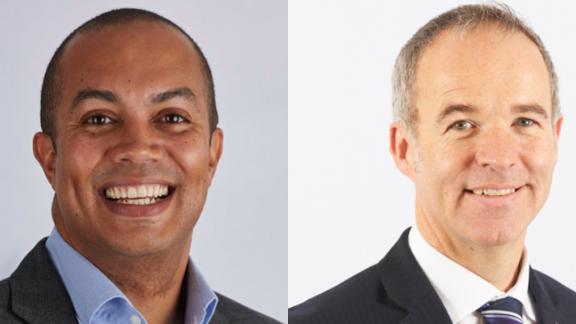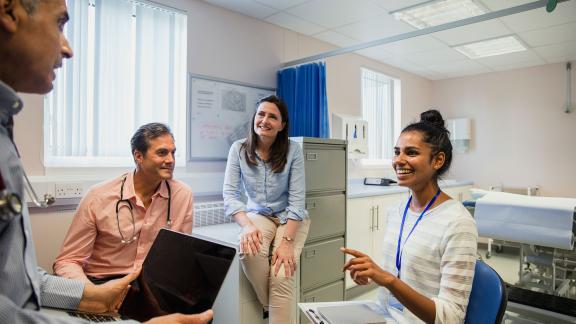NHS Reset: Using rapid insights to create an innovation learning system

NHS Reset is an NHS Confederation campaign to help shape what the health and care system should look like in the aftermath of the pandemic.
In this long read, Richard Stubbs and Rob Webster share West Yorkshire and Harrogate's approach to evaluating the behavioural and culture change that have happened in response to COVID-19, as well as the specific innovations and new ways of working that have sprung up over this period.
It was fairly early on in the pandemic when we stopped talking about “recovery” and started to refer to “reset”. As a partnership that brings our local NHS, councils and communities closer together to improve health and care for the 2.7 million people living across West Yorkshire and Harrogate (WY&H) we recognised that, given our scale, the immense work to transform our services to meet the challenges of COVID-19 was also an opportunity to learn and importantly share what we have learned.
The Yorkshire and Humber Academic Health Science Network (AHSN) is a membership organisation that brings together the NHS, local government, academia and business to drive innovation for health, for care and for the benefit of the economy. In WY&H, we have continued to operate in a way the supplements national funding for AHSNs with local contributions to fund local work and innovations. The idea is that the AHSN is ours and we all have “skin in the game”.
The AHSN leadership sits alongside our NHS, community and local authority organisations as a full member of the West Yorkshire and Harrogate Health and Care Partnership (also known as an integrated care system: ICS). The partnership is used to connect people – to focus on scale issues, wicked issues and sharing good practice. By blending the expertise and capacity of the AHSN with the ICS’s System and Leadership Development Programme, we were able to have a single approach to data collection and avoid duplicative asks of the system during the intensive first few months of tackling the pandemic.
Using a rapid insights methodology enabled us to quickly identify and analyse themes and agree areas of focus. The pace of transformation and change during the pandemic, with services going digital by default for example, highlighted the need to mobilise rapid evaluation of new pathways of care. Rapid insights gave us a vital, early sense of what was happening on the ground and how we could quickly either spread it or improve it – or come together to solve wicked issues. The work was undertaken from mid-May to mid-June 2020 and is part of the first stage in a continual improvement approach to inform the best practice, insights and embed learning.
Our intention was on capturing intelligence that provided insights into behavioural and culture change as much as identifying specific innovations or new ways of working. We did not have the luxury of conducting a review, inquiry or root-cause analysis of decisions made with the intent of judging what should or should not have happened during those first few months. Our approach relied on an appreciative inquiry mind-set, based on trust, openness and honesty.
To achieve this we adopted a mixed-methodology of surveys, semi-structured interviews, facilitated sessions and secondary research (including insights from external reports and complimentary literature produced by local Healthwatch organisations) and other research including Yorkshire Ambulance Service insights, a West Yorkshire-wide lessons learnt World Café event, and through attendance and involvement in at the NHS Yorkshire and Humber Nightingale Hospital based in Harrogate.
This research was compiled and grouped into seven themes to inform key findings. Figures 2-4 below outline some of these key findings, grouped into what has worked well, what could have been done differently and how we can build on learning to inform and improve for the future. It also built on a WY&H engagement mapping report which brought together key findings from Healthwatch and the Yorkshire Sikh Elders, to name just two.
What’s next?
The English health system ‘as we knew it’ is unlikely to be seen again, and as we continue to emerge and reset within the pandemic we will be faced with a ‘new norm’. We have an opportunity to implement a health and care system fit for the 21st century, which, in the long run, has the potential to look and feel very different, while continuing to deliver significant positive benefits, including high-quality care for communities and staff.
This will only be possible if we capture important learnings from the crisis which will inform and support us to continue these positive changes into the future. This will require a future likely be driven by behaviours, learning and changes which have arisen as a result of the response to COVID-19 and, importantly by remembering what we knew before COVID-19 struck – the system was failing to meet the needs of people in some communities and had to change.
Some of this work has already begun and will continue to be present in our future working life.The rapid insights have been used to support the partnership’s focus. Some examples of the new ways of working include:
- Redeployment of allied health professionals across Airedale NHS Foundation Trust, where staff from the large musculoskeletal service team moved to an acute patient team, allowing a seven-day footprint and extended working days. This change enabled an increase of therapy on the wards resulting in speedier discharge.
- Colleagues from Locala Community Partnerships, a community interest company, championed the national guidance to deliver digital-first services to continue supporting patients. Locala was able to build on systems and technology already available within its organisation to enable video consultations and phone consultations. The positive impact of this work has resulted in Locala working with each service to develop reformation plans. These include how to embed the technology and service changes going forward, as well ensuring ‘digital inclusion’.
- Leeds Teaching Hospitals NHS Trust requested volunteers to deliver personal protective equipment (PPE) training sessions to care homes across the locality, with each volunteer being allocated ten care homes. The deadline for delivery of all sessions was just two weeks. Sessions were coordinated by the community infection prevention and control team. This bridged the gap between community and hospital staff, which, prior to the pandemic, had never experienced this level of integration and collaboration.
There were 39 innovations captured from the programme. The AHSN will be running workshops aimed at supporting the embedding of these changes.
We know how much our colleagues have been impacted throughout the pandemic. System and leadership development will include support, alongside change interventions as well as a revised health and wellbeing offer.
Creating an innovation learning system
Our work in West Yorkshire and Harrogate will continue to evolve and sharpen in line with the learning from our rapid insights activity (and also many other areas). We’ll shortly be releasing a series of 12 case studies we’ve captured to demonstrate the impact and potential of what must be done. There remains more work to do to fully understand the effect of the pandemic and how we can adapt and respond. What is clear is that staff and the public will both drive change and accept change given the right conditions.
This work is just one part of a much bigger picture where our ICS is driving change built on insight, evaluation and evidence for improvement. The AHSN will be a partner in this sustainable future. We are already undertaking further analysis of some of the key changes that have occurred within West Yorkshire and Harrogate, using a quality improvement approach to assess the sustainability of our new ways of working. By embedding this in the governance and infrastructure of our ICS, we are building improvement into all we do.
We will take the learning from this work and bring this together with our work across the wider North East and Yorkshire Region to develop and implement a learning framework that will help us to innovate so we can further adapt and develop in what is an uncertain future.
For information on any of the above mentioned programmes, please email info@yhahsn.com
Richard Stubbs is chief executive of Yorkshire & Humber Academic Health Science Network. Follow him on Twitter @richarddstubbs. Rob Webster is chief executive lead for West Yorkshire and Harrogate Health and Care Partnership. Follow him on Twitter @NHS_RobW







